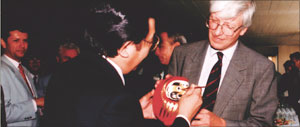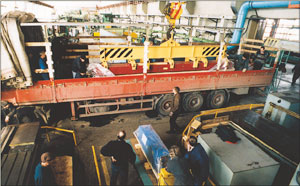Going global: Japan helps LHC construction (archive)

As CERN’s major project for the future, the LHC sets a new scale in world-wide scientific collaboration. As well as researchers and engineers from CERN’s European Member States, preparations for the LHC now include scientists from several continents. Some 50% of the researchers involved in one way or another with preparations for the LHC experimental programme now come from countries that are not CERN Member States.
Underlining this enlarged international involvement is the recent decision by the Japanese Ministry of Education, Science and Culture to accord CERN a generous contribution of ¥5 bn (about Sfr65 m) to help finance the construction of the LHC. This money will be held in a special fund earmarked for construction of specific LHC components and related activities.
At the June Council session, Japan was unanimously elected as a CERN Observer State, giving them the right to attend Council meetings. Speaking at the Council meeting in his new capacity as Observer State spokesman, Kaoru Yosano, Japan’s Minister of Education, Science and Culture, pointed to his country’s wish to contribute to the LHC project at an early stage. He said that large scientific projects like the LHC “captivated the imagination of citizens”.
• September 1995 p1 (extract).
CERN and Russia step up cooperation

The signing of a new protocol between CERN and Russia marks a considerable increase in joint collaboration and a further consolidation of ties dating back 30 years. As well as directly assisting construction of CERN’s new LHC proton collider, the protocol, within the framework of the 1993 CERN–Russia Cooperation Agreement, and with Russia as a CERN Observer State, will provide valuable further stimulus for Russian high technology.
Covering Russian participation in LHC construction and the preparations for its research programme over a 10 year period, the protocol includes two separate in-kind contributions, each with net value to CERN of Sfr67 m, for LHC construction and for the LHC detectors. In addition, a generous contribution from the Joint Institute for Nuclear Research at Dubna, near Moscow, will be invested in LHC preparations.
This latest two-way development in CERN/Russian collaboration will be to the mutual advantage of both parties. It will boost the LHC effort en route to completion of the machine at its full design collision energy of 14 TeV. In addition, the increased scope and scale of this challenging work, together with its inherent complexity and sophistication, will provide impetus to Russian science and industry, and provide vital transfer of front-line technology and skills.
As well as the new protocol, additional contributions to LHC experiments could come through the International Science Technology Centre programme funded by the European Union, Japan, Russia and the US to promote the integration of former Soviet Union weapons scientists into fresh projects, and where six particle physics projects have already been approved.
• September 1996 p32–33 (extract).
After the SSC
In the wake of the demise of the US Superconducting Supercollider (SSC) project, which impoverished both US and world science, some rapid scene shifting is going on. The SSC may be dead, but the underlying physics quest lives on.
To nurture the natural enthusiasm to continue this physics, contacts have been developing at several levels. In December 1993, informal exploratory talks were held at CERN between spokesmen of the LHC experiments and their counterparts from the major SDC and GEM projects which were being readied for the SSC, and with CERN management. The object was the common interest in multi-TeV physics at the LHC, and, once this is in place, to exploit valuable R&D already accomplished and the high level of expertise achieved in the SSC framework. A substantial number of US physicists involved in SDC and GEM could be interested in joining LHC experiments, together with Japanese researchers involved in SDC. Many of the SDC Canadian contingent could also turn their sights towards Geneva.








